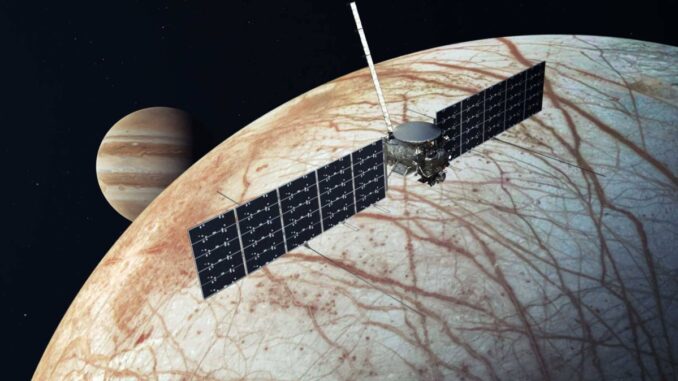
(UPDATE) CAPE CANAVERAL, Florida — A NASA spacecraft is ready to set sail for Jupiter and its moon Europa, one of the best bets for finding life beyond Earth.
Europa Clipper will peer beneath the moon’s icy crust, where an ocean is thought to be sloshing fairly close to the surface. It won’t search for life but rather determine whether conditions there could support it. Another mission would be needed to flush out any microorganisms lurking there.
“It’s a chance for us to explore not a world that might have been habitable billions of years ago, but a world that might be habitable today — right now,” said program scientist Curt Niebur.
Its massive solar panels make Clipper the biggest craft built by NASA to investigate another planet.
It will take 5 1/2 years to reach Jupiter and will sneak within 16 miles (25 kilometers) of Europa’s surface — considerably closer than any other spacecraft.
Liftoff is targeted for this month aboard SpaceX’s Falcon Heavy rocket from NASA’s Kennedy Space Center — mission cost: $5.2 billion.
One of Jupiter’s 95 known moons, Europa, is almost the size of our own moon. It’s encased in an ice sheet estimated to be 10 miles to 15 miles or more (15 kilometers to 24 kilometers) thick. Scientists believe this frozen crust hides an ocean that could be 80 miles (120 kilometers) or more deep. The Hubble Space Telescope has spotted what appear to be geysers erupting from the surface. Discovered by Galileo in 1610, Europa is one of the four so-called Galilean moons of Jupiter, along with Ganymede, Io and Callisto.
This illustration provided by NASA depicts the Europa Clipper spacecraft over the moon, Europa, with Jupiter at background left. NASA/JPL-CALTECH VIA AP
Seeking conditions that support life
What type of life might Europa harbor? Besides water, organic compounds are needed for life as we know it, plus an energy source. In Europa’s case that could be thermal vents on the ocean floor. Deputy project scientist Bonnie Buratti imagines any life would be primitive, like the bacterial life that originated in Earth’s deep ocean vents. “We will not know from this mission because we can’t see that deep,” she said. Unlike missions to Mars, where habitability is one of many questions, Clipper’s sole job is to establish whether the moon could support life in its ocean or possibly in any pockets of water in the ice.
Supersized spacecraft
When its solar wings and antennas are unfurled, Clipper is about the size of a basketball court — more than 100 feet (30 meters) end to end — and weighs nearly 13,000 pounds (6,000 kilograms). The supersized solar panels are needed because of Jupiter’s distance from the sun. The main body — about the size of a camper — is packed with nine science instruments, including radar that will penetrate the ice, cameras that will map virtually the entire moon and tools to tease out the contents of Europa’s surface and tenuous atmosphere. The name hearkens to the swift sailing ships of centuries past.
The roundabout trip to Jupiter will span 1.8 billion miles (3 billion kilometers). For extra oomph, the spacecraft will swing past Mars early next year and then Earth in late 2026. It arrives at Jupiter in 2030 and begins science work the next year. While orbiting Jupiter, it will cross paths with Europa 49 times. The mission ends in 2034 with a planned crash into Ganymede — Jupiter’s biggest moon and the solar system’s too.





Be the first to comment